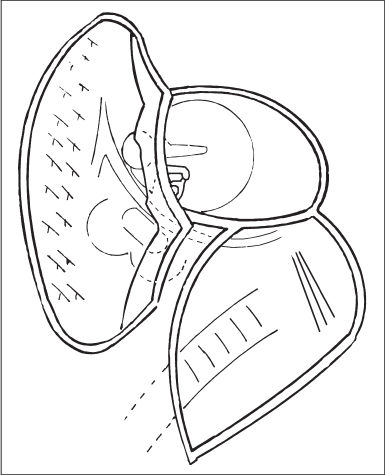III Techniques and Designs Developed by the Author 32 Minimally Invasive Cochlear Implantation with Mastoidal Three-layer Flap 33 Transposed CanalWall Tympanomastoidectomy 34 MCF Surgery Using Cochleariform Process as the Main Landmark 35 Ulug Double-sided Ear Microsurgery Instruments Drilling of the zygomatic root (ZR) area extensively, and exposure of the superior surface of the petrous bone including the perigeniculate area through the space created between the basal dura of the middle cranial fossa superiorly and the skeletonized external auditory canal inferiorly, without carrying out a craniotomy. The ZR approach can be carried out as an isolated technique, i.e., ZR isolated approach, or it can be combined with an inferior mastoidectomy, protecting the bony bridge in between, i. e., ZR combined approach. The ZR approach is used in cases of facial paralysis due to temporal bone fractures, Bell palsy and Ramsay Hunt syndrome. This approach may also be useful in cases of iatrogenic facial palsy, superior semicircular canal dehiscence, and limited petrous cholesteatoma or cholesterol granuloma. A retroauricular incision is made, with only a 2cm anterosuperior temporal extension at the zygomatic root; for the combined approach approximately 7cm in length, and only 4cm in length for the isolated approach. A classical Palva flap is prepared, followed by slight elevation of the inferior part of the temporal muscle, which is temporarily sutured to the temporal skin. The initial step is the drilling of the zygomatic root area, taking the zygomatic root as the center. During this step, instead of extirpating the bone, a 2×1cm cortical bone graft and bone dust are obtained to use for reconstruction at the end of the operation. Then extensive outside-in drilling is carried out, which consists of exenteration of the anterosuperior part of the mastoid and superior part of the petrous bone. In this way, the basal dura of the temporal lobe is completely exposed as in a middle cranial fossa approach. Following this, the superior wall of the external auditory canal is skeletonized, the tegmen tympani is opened, the dural attachment of the greater superficial petrosal nerve is located, and the superior semicircular canal is skeletonized or blue-lined according to the needs of the case. In cases of a combined approach, inferior mastoidectomy is added at this step, completely protecting the 0.5cmthick bony bridge which extends from the mastoid cortex laterally close to the semicircular canals medially. The bridge avoids the creation of a large mastoidopetrosal cavity requiring adipose tissue obliteration.

31 Zygomatic Root Approach
Definition
Indications
Surgical Technique

Zygomatic Root Approach
Only gold members can continue reading. Log In or Register to continue

Full access? Get Clinical Tree


